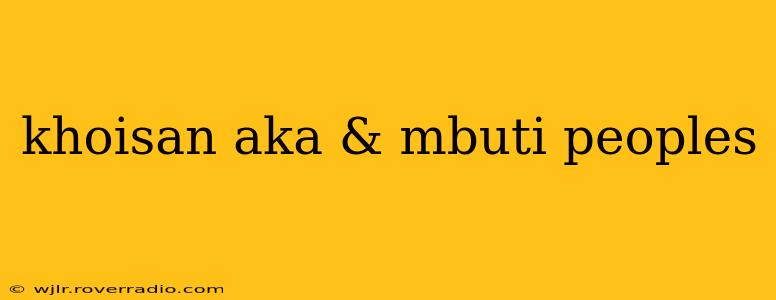The Khoisan and Mbuti peoples represent two distinct but fascinating groups of hunter-gatherers with rich histories and unique cultural adaptations. While geographically distant, both share the common thread of having maintained traditional lifestyles for millennia, offering valuable insights into human adaptability and societal structures. This article will explore their respective histories, cultures, and the challenges they face in the modern world.
Who are the Khoisan?
The Khoisan are a diverse group of indigenous peoples primarily inhabiting southern Africa. The term "Khoisan" itself is a linguistic classification encompassing two distinct language families: the Khoekhoe and the Tuu. These languages share unique click consonants, a distinctive phonetic feature not found in many other languages globally. The Khoisan are not a single homogenous group, but rather a collection of diverse tribes and clans, each with its own unique customs and traditions. Their history stretches back tens of thousands of years, making them among the oldest populations in Africa.
What are the different Khoisan groups?
The Khoisan peoples aren't a single unified group; rather, they comprise numerous distinct ethnic groups with varied languages, customs, and traditions. Some prominent groups include the Nama, the Damara, the San (often referred to as Bushmen), and the Korana. Each group has its own unique history and cultural practices, contributing to the overall diversity within the broader Khoisan classification. This diversity reflects the vast and varied landscapes they've inhabited across southern Africa.
What are the traditional ways of life of the Khoisan?
Traditionally, Khoisan societies were characterized by a nomadic or semi-nomadic hunter-gatherer lifestyle. Their survival depended heavily on their intimate knowledge of their environment, their skills in hunting and gathering, and their ability to adapt to changing conditions. They utilized diverse hunting and foraging techniques, depending on the season and the availability of resources. Social structures were often egalitarian, with a strong emphasis on kinship and cooperation.
Who are the Mbuti?
The Mbuti, also known as the Bambuti, are Pygmy peoples inhabiting the Ituri Forest of the Democratic Republic of the Congo. Unlike the Khoisan, who are spread across a large geographical area, the Mbuti are more geographically concentrated. They are renowned for their exceptional skills in hunting and gathering within the dense rainforest environment. Their way of life is deeply intertwined with the forest, and their survival depends on a profound understanding of its resources and ecology.
What are the unique cultural practices of the Mbuti?
The Mbuti culture is rich in oral traditions, music, and dance. Their music often plays a significant role in social gatherings and ceremonies. Their social organization is characterized by a relatively egalitarian structure, although there are recognized leaders who hold influence within their communities. They exhibit a strong sense of community and cooperation, essential for survival in their challenging environment. Their deep connection to the forest informs all aspects of their lives, from their beliefs and spiritual practices to their methods of food procurement.
What are the similarities and differences between Khoisan and Mbuti?
Both Khoisan and Mbuti peoples are characterized by their long history as hunter-gatherers, and they've both developed sophisticated techniques for survival in their respective environments. However, there are also significant differences. The Khoisan are spread over a vast area with diverse environments, resulting in a wider range of cultural adaptations. The Mbuti, on the other hand, are concentrated within the dense Ituri forest, their culture intrinsically linked to the unique ecology of that region. Linguistically, the click consonants of Khoisan languages stand in stark contrast to the Bantu languages of the Mbuti. Despite these differences, both groups represent vital components of human cultural and genetic diversity.
Challenges Facing the Khoisan and Mbuti Peoples Today
Both groups face significant challenges in the modern world, including land encroachment, resource depletion, and the pressure to assimilate into dominant cultures. Many Khoisan communities have faced displacement and dispossession of their traditional lands, impacting their livelihoods and cultural practices. Similarly, the Mbuti people have experienced encroachment on their forest home, leading to habitat loss and disruption of their traditional way of life. The pressures of modernization and globalization threaten the preservation of their unique cultures and traditional knowledge systems.
How are conservation efforts helping to protect the Khoisan and Mbuti peoples?
Various organizations are working to protect the lands and cultures of both Khoisan and Mbuti communities. Conservation efforts often involve working with indigenous communities to develop sustainable resource management strategies and to protect their traditional territories. Supporting indigenous-led initiatives is crucial, empowering communities to manage their own resources and preserve their cultural heritage.
This exploration offers just a glimpse into the rich tapestry of the Khoisan and Mbuti cultures. Further research and understanding of these ancient peoples are essential to ensuring the preservation of their invaluable contributions to human history and biodiversity.
